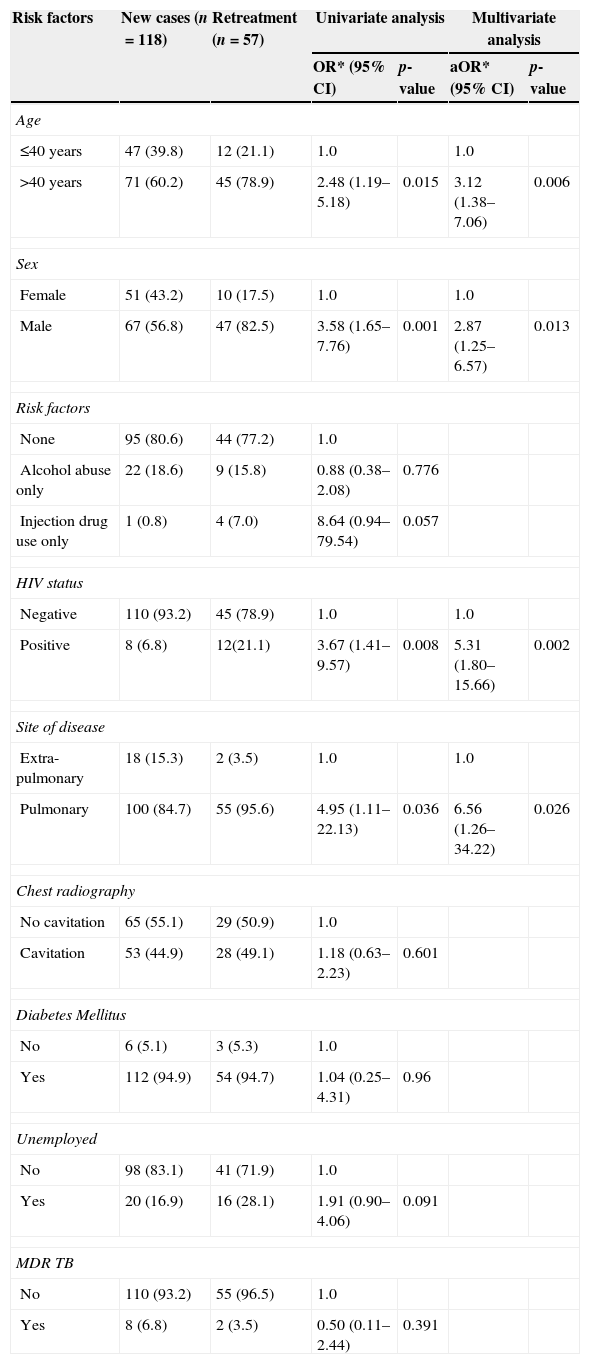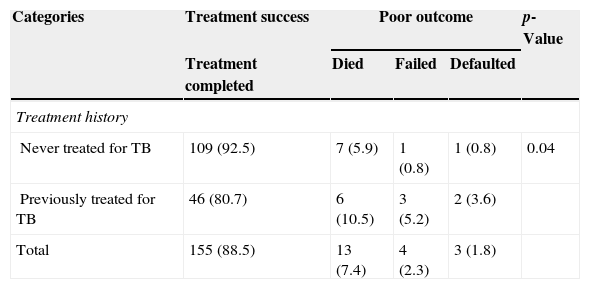Tuberculosis (TB) continues to be a global public health problem.
In Portugal, the incidence is higher in several urban centers, some of which are in northern Portugal, like Porto and Viana do Castelo (20–50 cases per 100,000 people). The retreatment takes place annually in these centers and the rate is also higher (2.97/100,000 people and 2.45/100,000 people, respectively) than in others in Portugal.1
The persistence of tuberculous bacilli in patients who are cured or in those whose treatment was not correctly completed is an important issue.2 Published risk factors for treatment failure or relapse include medical factors like HIV infection, diabetes mellitus, low body weight, cavitation on chest X-ray, high bacterial burden, short duration of treatment, drug resistance, positive culture after two months of treatment and socio-demographic factors like male gender, unemployment, drug abuse, alcoholism, smoking and poor treatment adherence.2–5
Retreatment cases are the leading risk factor for drug resistance if not appropriately and effectively managed, especially in HIV-seronegative patients.4,6
We carried out a study to assess risk factors and outcome for retreatment in TB patients in northern Portugal.
The World Health Organization (WHO) standard definition was used for treatment outcome (treatment success, death, failure, default and transferred out).3,5,7
The cases included were all retreatment TB cases (having received previous treatments) reported in 2012 in Northern Portugal and controls were the new cases (having received no previous treatment for TB) that were registered during the same period. Cases and controls were selected from the national database, which integrates the data from the mandatory registration of TB. For each case we randomly selected 2 controls. Risk factors (male sex, age over 40, HIV infection, diabetes mellitus, drug resistance, cavitation on chest X-ray, pulmonary vs. extra-pulmonary TB, unemployment, intravenous drug abuse and alcohol abuse) and outcomes for retreatment cases were compared against those for new cases.
We analyzed 57 cases and 118 controls (Table 1). In the cases, the median age was 48.0 years (range: 27.0–83.0) and 47 patients (82.5%) were male. In controls, the median age was 45.0 years (range: 14.0–85.0) and 67 patients (56.8%) were male.
Risk factors for retreatment.
| Risk factors | New cases (n=118) | Retreatment (n=57) | Univariate analysis | Multivariate analysis | ||
|---|---|---|---|---|---|---|
| OR* (95% CI) | p-value | aOR* (95% CI) | p-value | |||
| Age | ||||||
| ≤40 years | 47 (39.8) | 12 (21.1) | 1.0 | 1.0 | ||
| >40 years | 71 (60.2) | 45 (78.9) | 2.48 (1.19–5.18) | 0.015 | 3.12 (1.38–7.06) | 0.006 |
| Sex | ||||||
| Female | 51 (43.2) | 10 (17.5) | 1.0 | 1.0 | ||
| Male | 67 (56.8) | 47 (82.5) | 3.58 (1.65–7.76) | 0.001 | 2.87 (1.25–6.57) | 0.013 |
| Risk factors | ||||||
| None | 95 (80.6) | 44 (77.2) | 1.0 | |||
| Alcohol abuse only | 22 (18.6) | 9 (15.8) | 0.88 (0.38–2.08) | 0.776 | ||
| Injection drug use only | 1 (0.8) | 4 (7.0) | 8.64 (0.94–79.54) | 0.057 | ||
| HIV status | ||||||
| Negative | 110 (93.2) | 45 (78.9) | 1.0 | 1.0 | ||
| Positive | 8 (6.8) | 12(21.1) | 3.67 (1.41–9.57) | 0.008 | 5.31 (1.80–15.66) | 0.002 |
| Site of disease | ||||||
| Extra-pulmonary | 18 (15.3) | 2 (3.5) | 1.0 | 1.0 | ||
| Pulmonary | 100 (84.7) | 55 (95.6) | 4.95 (1.11–22.13) | 0.036 | 6.56 (1.26–34.22) | 0.026 |
| Chest radiography | ||||||
| No cavitation | 65 (55.1) | 29 (50.9) | 1.0 | |||
| Cavitation | 53 (44.9) | 28 (49.1) | 1.18 (0.63–2.23) | 0.601 | ||
| Diabetes Mellitus | ||||||
| No | 6 (5.1) | 3 (5.3) | 1.0 | |||
| Yes | 112 (94.9) | 54 (94.7) | 1.04 (0.25–4.31) | 0.96 | ||
| Unemployed | ||||||
| No | 98 (83.1) | 41 (71.9) | 1.0 | |||
| Yes | 20 (16.9) | 16 (28.1) | 1.91 (0.90–4.06) | 0.091 | ||
| MDR TB | ||||||
| No | 110 (93.2) | 55 (96.5) | 1.0 | |||
| Yes | 8 (6.8) | 2 (3.5) | 0.50 (0.11–2.44) | 0.391 | ||
The number of cases of pulmonary TB was higher in retreatment group (96.5% vs. 84.7%, p=0.04). There were no differences when factors such as diabetes mellitus, immunosuppression, drug resistance, unemployment, intravenous drug abuse and alcohol abuse were compared.
Male sex (adjusted OR: 2.87, 95% CI: 1.25–6.57, p=0.013), HIV-positive status (adjusted OR: 5.31, 95% CI: 1.80–15.66, p=0.002) and age over 40 (adjusted OR: 3.12, 95% CI: 1.38–7.06, p=0.006) were independent risk factors identified for retreatment (Table 1). Of the 57 retreatment cases identified, 46 (81%) had been successfully treated in the past.
The treatment success rate was lower among patients who had received prior TB treatment than in patients who had never been treated for TB (80.7% vs. 92.5%, p=0.04). In retreatment group 6 patients (10.5%) died while 7 patients (5.9%) died among the new cases, although this was not a statistically significant difference (p=0.36) (Table 2).
Male sex appears as a risk factor for retreatment, in ours and in other studies.2–4,8 Although it is not fully understood why this is a risk factor for retreatment of tuberculosis, it is thought that this may be due to habits associated more to men than women as smoking, intravenous drug abuse and alcohol abuse.
Dooley et al.3 commented that although retreatment guidelines are often the same for patients with failure of, default from, or relapse after initial treatment, these groups may benefit from different management strategies.
The number of cases of pulmonary TB was also higher in the retreatment group, although there are no studies in the literature that can explain this result.
In our population there were no differences when comparing factors such as diabetes mellitus, drug resistance, unemployment, intravenous drug abuse and alcoholism.
The low rate of multi drug resistance (MDR) TB in the retreatment group and the fact that there were no statistically significant differences when compared with the control group suggests that these patients may not have been exposed to many drugs in the past or that they had had a complete treatment, which was also noted by Kritski et al. in their population.6
Despite this result, the treatment success rate was lower among patients who had received prior TB treatment than in patients who had never been treated for TB.
Identifying local patient characteristics that confer higher risk of relapse, failure or default from primary TB treatment may help inform country-specific prevention strategies aiming to reduce the need for retreatment, resulting in cost savings and diminished morbidity and transmission.
Conflict of interestThe authors have no conflicts of interest to declare.








